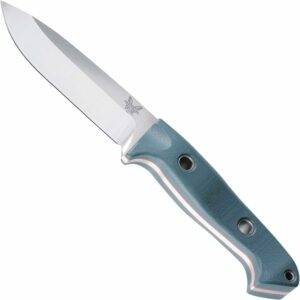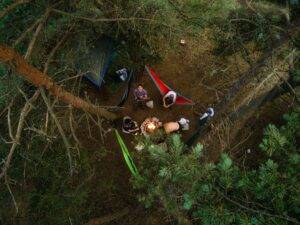Gourmet wilderness cooking is the art of preparing delicious and high-quality meals in the great outdoors. It goes beyond the traditional camping fare of hot dogs and canned beans, and instead focuses on using fresh ingredients and creative techniques to create gourmet dishes. This type of cooking allows outdoor enthusiasts to enjoy the beauty of nature while still indulging in delicious and satisfying meals.
There are several benefits to gourmet wilderness cooking. Firstly, it allows campers to elevate their outdoor experience by adding a touch of luxury and sophistication to their meals. Instead of settling for basic and uninspiring food, gourmet wilderness cooking allows campers to enjoy restaurant-quality dishes in the midst of nature.
Secondly, gourmet wilderness cooking can be a fun and rewarding challenge. It requires creativity, resourcefulness, and adaptability, as campers must work with limited equipment and ingredients. This type of cooking can be a great way to test your culinary skills and push yourself outside of your comfort zone.
Lastly, gourmet wilderness cooking can enhance the overall camping experience. Sharing a delicious meal with friends or family around a campfire can create lasting memories and deepen connections. It can also provide a sense of comfort and familiarity in an unfamiliar environment.
To successfully engage in gourmet wilderness cooking, it is important to have the proper equipment and tools. Investing in high-quality camping gear will make the cooking process easier, more efficient, and more enjoyable. From portable stoves to cutting tools, having the right equipment will ensure that you can prepare gourmet meals with ease while enjoying the great outdoors.
Why You Need Essential Gadgets for Campsite Cooking
Cooking in the wilderness presents its own unique set of challenges. Unlike cooking in a well-equipped kitchen, campsite cooking requires you to work with limited resources and adapt to the elements. This is why having essential gadgets for campsite cooking is crucial.
One of the main challenges of campsite cooking is the lack of a proper kitchen setup. Without a stove, oven, or countertop, it can be difficult to prepare meals efficiently. This is where essential gadgets come in. Gadgets such as portable stoves, camping grills, and Dutch ovens can provide the necessary heat source for cooking. They are designed to be lightweight, compact, and easy to use, making them perfect for outdoor cooking.
Another challenge of campsite cooking is the limited storage space. Unlike a kitchen pantry or refrigerator, you have to carefully select the ingredients and tools you bring with you. Essential gadgets can help maximize your storage space by serving multiple purposes. For example, a multi-tool can function as a knife, can opener, and bottle opener all in one.
Some examples of essential gadgets for campsite cooking include a camping stove, a portable grill, a Dutch oven, a multi-tool, and a collapsible water container. These gadgets are designed specifically for outdoor use and are built to withstand the elements. They are also lightweight and compact, making them easy to transport and store.
Portable Stoves and Fuel Sources for Gourmet Cooking
When it comes to gourmet wilderness cooking, having a reliable portable stove is essential. A portable stove provides the heat source needed to cook your meals and allows you to have more control over the cooking process.
There are several types of portable stoves available on the market. The most common types include propane stoves, butane stoves, and alcohol stoves. Propane stoves are popular due to their high heat output and ease of use. They are fueled by small propane canisters that are readily available at camping stores. Butane stoves are similar to propane stoves but use butane gas canisters instead. Alcohol stoves are lightweight and compact but have a lower heat output compared to propane or butane stoves.
When choosing a fuel source for your portable stove, it is important to consider factors such as availability, cost, and environmental impact. Propane and butane canisters are widely available and relatively affordable, making them popular choices. However, they are not as environmentally friendly as alcohol stoves, which use denatured alcohol as fuel.
When selecting a portable stove and fuel source, it is important to consider your specific needs and preferences. If you prioritize convenience and high heat output, a propane or butane stove may be the best option for you. If you are concerned about the environment and prefer a lightweight and compact option, an alcohol stove may be more suitable.
Essential Cookware and Utensils for Campsite Cooking
Having the right cookware and utensils is crucial for gourmet wilderness cooking. The right tools can make the cooking process easier, more efficient, and more enjoyable.
When it comes to cookware, durability and portability are key. Look for cookware that is made from lightweight materials such as aluminum or stainless steel. These materials are durable, heat-resistant, and easy to clean. Non-stick coatings can also be beneficial for easy food release and cleaning.
Some essential cookware items for campsite cooking include a frying pan, a pot, a griddle, and a Dutch oven. A frying pan is versatile and can be used for sautéing, frying, or even baking. A pot is necessary for boiling water or cooking soups and stews. A griddle is great for cooking pancakes, bacon, or grilled sandwiches. A Dutch oven is a versatile piece of cookware that can be used for baking bread, roasting meats, or simmering stews.
In addition to cookware, having the right utensils is also important. Look for utensils that are lightweight, compact, and durable. Some essential utensils for campsite cooking include a spatula, tongs, a whisk, a ladle, and a can opener. These utensils will allow you to prepare and serve your meals with ease.
Keeping Your Food Fresh: Coolers and Ice Packs
Keeping your food fresh in the wilderness is crucial for both safety and enjoyment. Proper food storage can prevent spoilage, maintain food quality, and reduce the risk of foodborne illnesses.
One of the most effective ways to keep your food fresh is by using coolers and ice packs. Coolers are insulated containers that help maintain a cold temperature, while ice packs are frozen gel packs that provide a cooling effect.
There are several types of coolers available, ranging from basic coolers to high-end models with advanced insulation technology. When choosing a cooler, consider factors such as size, insulation, and durability. Look for coolers that are large enough to hold all of your food and beverages, have thick insulation to maintain a cold temperature, and are made from durable materials that can withstand the rigors of outdoor use.
When it comes to ice packs, there are two main types: reusable ice packs and disposable ice packs. Reusable ice packs are filled with a gel-like substance that freezes when placed in the freezer. They can be reused multiple times and are more environmentally friendly than disposable ice packs. Disposable ice packs are filled with water or a similar substance and are designed for single use. They are convenient but can generate waste.
To use coolers and ice packs effectively, it is important to follow some tips. Firstly, pre-chill your cooler before adding food to ensure that it stays cold for longer. Secondly, pack your cooler strategically by placing perishable items at the bottom and layering them with ice packs. Lastly, keep your cooler out of direct sunlight and avoid opening it frequently to maintain a cold temperature.
Spices, Seasonings, and Condiments for Gourmet Wilderness Cooking

Flavor is an important aspect of gourmet wilderness cooking. Adding spices, seasonings, and condiments to your meals can elevate the taste and make your dishes more enjoyable.
When it comes to spices and seasonings, it is important to bring a variety of options to suit different dishes. Some essential spices and seasonings to bring include salt, pepper, garlic powder, onion powder, paprika, and dried herbs such as oregano, thyme, and rosemary. These basic spices and seasonings can be used to enhance the flavor of meats, vegetables, and grains.
Condiments are also important for adding flavor and moisture to your meals. Some essential condiments to bring include ketchup, mustard, mayonnaise, hot sauce, and soy sauce. These condiments can be used to dress up sandwiches, burgers, or salads.
When storing spices, seasonings, and condiments in the wilderness, it is important to keep them in airtight containers to prevent moisture and pests from getting in. Small plastic or glass containers with screw-on lids are ideal for this purpose. Labeling the containers can also help you easily identify the contents.
Cutting and Chopping Tools for Campsite Meal Prep
Proper cutting and chopping tools are essential for campsite meal prep. They allow you to prepare ingredients efficiently and safely.
Some essential cutting and chopping tools for campsite cooking include a chef’s knife, a cutting board, a paring knife, and kitchen shears. A chef’s knife is versatile and can be used for a wide range of tasks such as slicing, dicing, and mincing. A cutting board provides a stable surface for cutting and protects your knife blade. A paring knife is smaller and more maneuverable than a chef’s knife, making it ideal for tasks such as peeling or trimming. Kitchen shears are useful for cutting herbs or opening packaging.
When using cutting and chopping tools in the wilderness, it is important to follow some safety tips. Always use a stable surface for cutting, such as a cutting board or a flat rock. Keep your fingers away from the blade and use a claw grip to hold the food securely. Make sure your knives are sharp, as dull knives can be more dangerous than sharp ones.
Lighting and Fire Starters for Cooking in the Wilderness
Proper lighting and fire starters are essential for cooking in the wilderness. They provide the necessary illumination and heat source for cooking.
When it comes to lighting, there are several options available. Headlamps and flashlights are portable and provide hands-free lighting. Lanterns are larger and can provide more ambient light. Solar-powered lights are a sustainable option that can be charged during the day and used at night.
Fire starters are crucial for starting a fire, which is often necessary for cooking in the wilderness. Some common fire starters include matches, lighters, and fire starters made from wax or other flammable materials. It is important to have multiple fire starters in case one fails.
When using lighting and fire starters in the wilderness, it is important to follow safety guidelines. Keep flammable materials away from open flames and never leave a fire unattended. Make sure to fully extinguish the fire before leaving the campsite.
Cleaning and Sanitizing Tools for Safe Campsite Cooking
Proper cleaning and sanitizing tools are essential for safe campsite cooking. They help prevent cross-contamination and reduce the risk of foodborne illnesses.
Some essential cleaning and sanitizing tools for campsite cooking include dish soap, scrub brushes, dish towels, and sanitizing wipes. Dish soap is used to clean dishes, utensils, and cookware. Scrub brushes help remove food particles and grease. Dish towels are used for drying dishes and utensils. Sanitizing wipes can be used to sanitize surfaces such as cutting boards or countertops.
When cleaning and sanitizing in the wilderness, it is important to follow some guidelines. Use hot water and soap to clean dishes and utensils. Scrub thoroughly to remove any food particles. Rinse with clean water and air dry or use a dish towel to dry. To sanitize surfaces, use sanitizing wipes or a mixture of water and bleach.
Tips and Tricks for Gourmet Wilderness Cooking Success
To ensure success in gourmet wilderness cooking, here are some tips and tricks to keep in mind:
1. Plan and prepare meals in advance: Before heading out into the wilderness, plan your meals and make a shopping list. Preparing ingredients in advance, such as chopping vegetables or marinating meats, can save time and make cooking easier.
2. Pack ingredients in individual portions: To save space and reduce waste, pack ingredients in individual portions. This will make meal preparation more efficient and prevent spoilage.
3. Use foil packets for easy cooking: Foil packets are a convenient way to cook meals in the wilderness. Simply wrap your ingredients in foil and place them over a campfire or on a grill. This method allows for easy cleanup and prevents cross-contamination.
4. Experiment with different cooking methods: Don’t be afraid to try different cooking methods such as grilling, baking, or steaming. This will add variety to your meals and allow you to explore different flavors and textures.
5. Stay safe and comfortable: Always prioritize safety when cooking in the wilderness. Follow proper food handling practices, keep a safe distance from open flames, and use caution when using sharp tools. Additionally, make sure to bring comfortable camping gear such as chairs, tables, and tents to create a pleasant cooking environment.
Gourmet wilderness cooking is a unique and rewarding outdoor experience that allows you to enjoy delicious meals while surrounded by nature. By investing in the proper equipment and tools, you can elevate your camping experience and create memorable meals that rival those from a restaurant kitchen. From portable stoves to cutting tools, coolers to spices, having the right gear will make gourmet wilderness cooking easier, more efficient, and more enjoyable. So next time you head out into the great outdoors, don’t settle for basic camping fare – try your hand at gourmet wilderness cooking and discover a whole new world of culinary possibilities.
If you’re planning a gourmet camping adventure, you’ll need more than just essential cooking gadgets. One important aspect of any camping trip is ensuring your gear stays dry, especially if you’re going on a kayak camping trip. In the article “Choosing the Right Waterproof Bags for Kayak Camping,” you’ll find valuable tips and recommendations on how to keep your belongings safe and dry during your outdoor escapades. From dry bags to waterproof backpacks, this article will help you choose the right gear to protect your essentials while enjoying the great outdoors.
FAQs
What is the article about?
The article is about essential gadgets for campsite cooking.
Why is it important to have the right gadgets for campsite cooking?
Having the right gadgets for campsite cooking can make the experience more enjoyable and efficient.
What are some essential gadgets for campsite cooking?
Some essential gadgets for campsite cooking include a portable stove, a camping cookware set, a cooler, a camping grill, and a multi-tool.
What should I look for when choosing a portable stove?
When choosing a portable stove, you should consider the type of fuel it uses, its size and weight, and its cooking power.
What should I look for when choosing a camping cookware set?
When choosing a camping cookware set, you should consider its size and weight, the materials it is made of, and whether it includes essential items like a pot, pan, and utensils.
What should I look for when choosing a cooler?
When choosing a cooler, you should consider its size and capacity, its insulation, and whether it has additional features like wheels or a built-in bottle opener.
What should I look for when choosing a camping grill?
When choosing a camping grill, you should consider its size and weight, the type of fuel it uses, and whether it has additional features like a built-in thermometer or adjustable heat settings.
What is a multi-tool and why is it useful for campsite cooking?
A multi-tool is a versatile tool that includes a variety of functions like a knife, scissors, pliers, and screwdrivers. It is useful for campsite cooking because it can be used for a variety of tasks like opening cans, cutting food, and repairing equipment.




